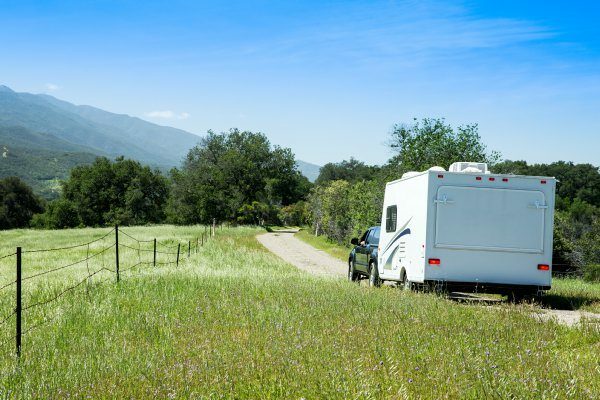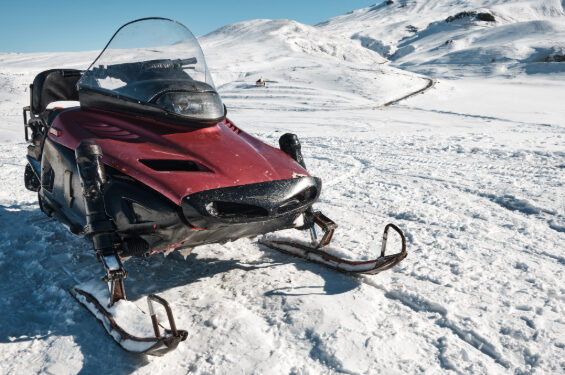
There are few things more frightening while towing your recreational vehicle than trailer sway. A sudden gust, a passing 18-wheeler or a quick steering correction can start your trailer swaying or fishtailing. The loss of control can mean tipping your valuable recreational vehicle or causing a serious accident.
Even the most experienced drivers have lost control of their towed trailers with disastrous results. A brief encounter with sway on the highway can quickly put a damper on your vacation and make you think about putting the camper back in the garage or up for sale. This article can help you understand what causes trailer sway and help keep yours upright.
What causes trailer sway?
Listed below are the most common causes of trailer sway.
1. Hitch adjustments
Any trailer towed with a hitch set behind the rear axle of the tow vehicle can sway or fishtail while driving. The hitch acts as a pivot point between the centers of gravity of the two vehicles. Any trailer sway or side-to-side force will turn the vehicle and create an unexpected steering force.
If that sideways force is strong enough, it can be more powerful than the road-tire friction of the drive wheels on the vehicle. This can cause the trailer, and maybe even the truck or car, to tip over or separate.
2. Wind and drafts
A truck passing at a fast speed can cause a powerful gust of wind, hitting your trailer and creating side-to-side movement. It’s almost impossible to avoid this happening on most roads, so you should expect this to happen and equip your truck with RV sway control systems that help reduce swaying caused by crosswinds. [1]
Because trailers tend to be taller and wider than other vehicles on the road, they are more sensitive to crosswinds. This causes the “sail effect,” which happens when the trailer catches the wind. If the wind comes from the side, this can change its trajectory. However, if the wind comes from the front, it slows down the trailer, and if it comes from the back, it accelerates the trailer. And the impact of the wind on the road can be quite dangerous. In 2020, there were more than 1,000 large truck crashes due to severe crosswinds. [2]
To safely tow a trailer, it’s recommended to reduce your usual operating speed based on the severity of the wind. The safe driving speed decreases as wind speed increases. [3]
3. Weight distribution and balance
Since one of the main reasons that trailers sway is improper load placement, it’s important to balance your load. It’s also important that your trailer weight does not exceed axle ratings, towing capacity or weight ratings of the hitch, receiver or hitch ball. [3a]
Having an imbalance of weight in your trailer can be dangerous, making it swing more dramatically once a sway starts, like a pendulum around its center of gravity. [4]
10 tips to prevent trailer sway
The best way to correct trailer sway is to avoid it in the first place. Follow these general tips when towing:
- Use the manufacturer-recommended gear when towing.
- Slow down. Moderate driving speeds produce less strain on your vehicle and trailer, reducing the chance for trailer sway.
- Stay vigilant of what’s happening around you. Avoid sudden steering maneuvers.
- Check the tire pressure. Underinflated tires reduce the load-carrying capacity of your vehicle or trailer, which can cause sway.
- Don’t drive onto a soft shoulder when passing. This could cause your trailer to jackknife or sway out of control.
- Make wider turns at corners and curves.
- Release the accelerator and grip the steering wheel when larger vehicles pass you.
- Check that the hitch is secured to the trailer that you are towing.
- When turning or adjusting direction, make slight movements of the steering wheel.
- If you have an electric trailer brake system, activate it if swaying occurs. Applying your tow vehicle brakes in an attempt to correct the situation could actually increase the sway. [5]
Evenly distributing the cargo weight toward the front of the trailer should help reduce instability and sway. The tongue weight of the trailer, or the downward weight at the front of the trailer carried by the hitch ball, is determined by the placement of the cargo. Your average tongue weight should be 10% to 15% of your overall weight. [6]
To distribute the weight in your trailer correctly, follow the 60/40 rule. 60% of the weight should be in the front of the axle, while 40% should be placed behind the axle. If you accidentally load too much cargo into the front (exceeding the 10-15% tongue weight range mentioned above), you could experience increasingly poorer handling of your vehicle and trailer. [6]
How to reduce trailer sway
Several hitch designs claim to reduce sway through differences in design. Do your research on which hitch is right for your vehicle, your trailer, and your load weight.
Sway control hitches
There are several options, including friction bar sway control, 2- and 4-point sway control, electronic and duel-cam sway control systems. Each type offers its own advantages and disadvantages for the context. Make sure you understand your towing specifications and the capabilities and limitations of each type before choosing one and hitting the road. [6a]
Weight distribution hitches
Weight distribution hitches use special parts to distribute the tongue weight of the trailer among all the axles, on both the tow vehicle and trailer. As stated above, when the trailer weight is unevenly distributed, it can lead to poor handling and sway. Weight distribution hitches are aimed at mitigating any imbalance to create a smoother and safer ride. [7]
Controlling trailer sway
If your trailer starts to sway on the road, activate the manual trailer brake controloverride by hand by following these steps:
- Lift your foot from the accelerator to reduce your speed but don’t step on the brake pedal unless you’re in danger of hitting something.
- Keep a firm grip on the steering wheel to control sway caused by large passing vehicles and make sure to not increase your speed.
- Find a safe place to park and check for proper weight balance and hitch adjustment. [8]
Hooking up and towing a trailer or camper might not seem difficult, but the hitching process can be tough.
Key takeaways
Prevent trailer sway and control it when it happens by:
- Using the manufacturer-recommended gear.
- Slowing down: Moderate driving speeds produce less strain on your vehicle and trailer reducing the chance for trailer sway.
- Avoiding sudden turns: Don’t make any sudden steering maneuvers.
- Checking the tire pressure: Under-inflated tires reduce the load-carrying capacity of your vehicle or trailer, which can cause sway.
- Controlling trailer sway: Lift your foot from the accelerator but don’t step on the brake pedal unless you’re in danger of hitting something. Keep a firm grip on the steering wheel, find a safe place to park and check for proper weight balance and hitch adjustment.
- Checking weight distribution: Make sure that the load is evenly balanced on both sides to avoid sway.
Sources:
[1] “Causes of Trailer Sway and How to Prevent Them,” hayesbc.com/causes-of-trailer-sway-and-how-to-prevent-them (accessed June 9, 2023).
[2] “Crashes Involving Large Trucks by Weather Conditions and Crash Severity, 2020,” fmcsa.dot.gov/safety/data-and-statistics/crashes-table-20-crashes-involving-large-trucks-weather-conditions-and-6 (accessed June 28, 2023).
[3] “Analysis of Operating Safety of Tractor-Trailer under Crosswind in Cold Mountainous Areas,” mdpi.com/2076-3417/12/24/12755/pdf (accessed June 9, 2023).
[3a] “Definitive Guide to Safe Towing,” weigh-safe.com/towing-safety/definitive-guide-to-safe-towing/ (accessed June 28, 2023).
[4] “Top 10 Towing Risks to Keep in Mind,” https://auto.howstuffworks.com/auto-parts/towing/vehicle-towing/maneuvers/10-towing-risks-to-keep-in-mind.htm (accessed June 28, 2023).
[5] “Towing a Trailer: Being Equipped for Safety,” dco.uscg.mil/Portals/9/DCO%20Documents/5p/CG-5PC/CG-CVC/CVC3/training/dmgcontrol/G-PCV-3_CFVS_DC_Trainer_NHTSA_TowingSafety.pdf (accessed June 28, 2023).
[6] “How To Properly Load A Trailer for Safety,” weigh-safe.com/towing-safety/how-to-properly-load-your-trailer/ (accessed June 28, 2023).
[6a] “What is the best sway control hitch for me?” etrailer.com/faq-which-sway-control-hitch.aspx (accessed June 28, 2023).
[7] “Best Weight Distribution Hitches For 2023,” forbes.com/home-improvement/garage/car-accessories/best-weight-distribution-hitches/ (accessed June 28, 2023).
[8] “Methods For Trailer Sway Control,” thervgeeks.com/trailer-sway-control (accessed Feb. 26, 2023).
Disclaimer:
The information included here is designed for informational purposes only. It is not legal, tax, financial or any other sort of advice, nor is it a substitute for such advice. The information may not apply to your specific situation. We have tried to make sure the information is accurate, but it could be outdated or even inaccurate in parts. It is the reader’s responsibility to comply with any applicable local, state or federal regulations. Nationwide Mutual Insurance Company, its affiliates and their employees make no warranties about the information nor guarantee of results, and they assume no liability in connection with the information provided. Nationwide and the Nationwide N and Eagle are service marks of Nationwide Mutual Insurance Company. © 2024 Nationwide



